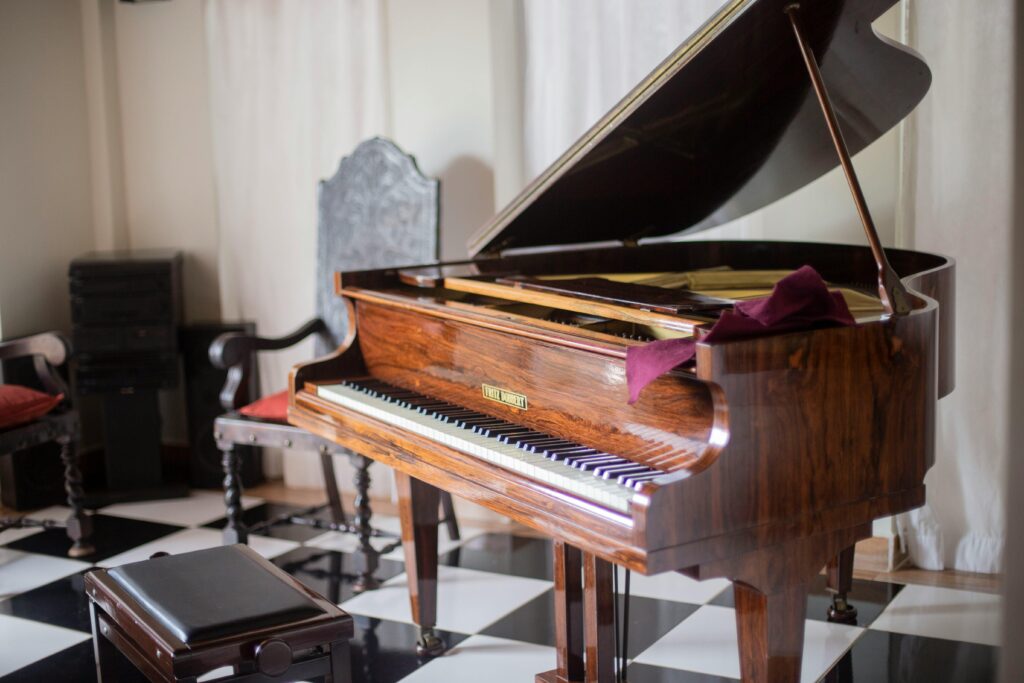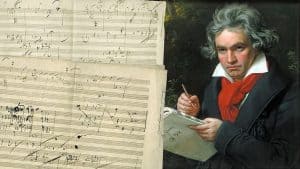Antonio Vivaldi’s The Four Seasons remains one of the most iconic works in classical music to this day. Composed in the early 18th century this set of violin concertos vividly portrays the shifting moods and imagery of Spring, Summer, Autumn and Winter.
Vivaldi’s genius for capturing the essence of nature through music has ensured the enduring popularity of The Four Seasons, making it a concert hall favorite and a cultural touchstone. This article delves into the rich history of this Baroque masterpiece, its reception over the centuries, and why it continues to captivate and inspire audiences around the world today.
- Fall in love with the music - Learn your favorite songs, at a level suitable for you.
- Enjoy interactive piano lessons - Explore courses covering music theory, technique chords & more.
- Get real-time feedback - Skoove's feedback tells you what went well and what needs practice.

Who was Antonio Vivaldi?
The Four Seasons composer was born in 1678 in Venice, a vibrant city that provided the ideal setting for his remarkable career. The son of a professional violinist, Vivaldi was immersed in music from an early age and later became a violin virtuoso himself. Although he trained as a priest and was nicknamed “Il Prete Rosso” or the “Red Priest” due to his striking red hair, his true passion was always music. This devotion led him to become one of the most celebrated composers of the Baroque period.
As the composer of The Four Seasons, Vivaldi revolutionized the concerto form by using music to vividly express stories and emotions. His innovative approach to composition and performance set him apart, writing hundreds of concertos, operas, sacred choral works and chamber music. Vivaldi left a lasting impact on the Baroque era, influencing generations of musicians and securing his place as one of the most important figures in classical music history.
Context and inspiration behind ”The Four Seasons”
The Four Seasons background is extremely fascinating. The early 18th century in Venice was a time of great artistic flourishing, particularly in Baroque music, which was known for its expressive melodies, dynamic contrasts and intricate ornamentation. Vivaldi, as a leading figure of this era, aimed to capture the natural world and human experiences in his compositions.
The Four Seasons is part of a larger collection titled Il cimento dell’armonia e dell’inventione (The Contest between Harmony and Invention), published in 1725. Each of the four concertos Spring, Summer, Autumn and Winter, offers a vivid musical portrayal of the essence of each season, rich in storytelling and emotion.
What sets these concertos apart is the inclusion of four sonnets, likely written by Vivaldi himself, to accompany the music. These sonnets describe the imagery and events that each concerto represents, adding a poetic dimension to the listener’s experience.
Vivaldi’s use of instrumental music to convey a narrative was groundbreaking for the time, as programmatic music—music that evokes scenes or tells stories—was still a relatively new concept. Vivaldi was among the first to explore this territory so extensively, and his work helped pave the way for future composers to blend literature and music in innovative ways.
Structure of ”The Four Seasons”
Each concerto in The Four Seasons follows a three-movement structure: fast-slow-fast. Vivaldi composed the music to reflect the scenes and emotions depicted in his accompanying sonnets.
Let’s take a closer look at how he brought each season to life:
Spring (La Primavera)
The first concerto in the series opens with joy and vitality, mirroring the renewal of life after winter.
The opening movement, with bright, uplifting melodies, represents birds singing and streams flowing. In the slower second movement Vivaldi paints a tranquil scene of a shepherd resting while his faithful dog barks gently in the background.
Summer (L’Estate)
The mood shifts dramatically in Summer. The opening is languid, evoking the oppressive heat of summer, followed by the unsettling sound of a distant thunderstorm.
The second movement continues the feeling of impending danger. The final movement erupts into a violent storm with dramatic and forceful violin passages representing lightning and thunder.
Autumn (L’Autunno)
Autumn captures the festive nature of the harvest season. The first movement portrays villagers celebrating the harvest with song and dance, eventually drinking to the point of sleep.
The second movement shows those who have fallen asleep in a peaceful slumber, while the final movement turns to a lively hunt, complete with the sounds of hunting horns and barking dogs.
Winter (L’Inverno)
To conclude, Winter depicts the cold, harsh conditions of the season. The shivering in the cold wind is portrayed through rapid, repeated notes on the violin.
The slower second movement gives a sense of warmth and coziness, as if sitting by a fire, while the final movement illustrates people carefully walking on ice trying not to slip and fall.
Through this imaginative and descriptive approach Vivaldi painted a vivid picture of each season, making The Four Seasons one of the earliest and most iconic examples of programmatic music.
Seasonal imagery and connections to the sonnets
One of the most fascinating aspects of The Four Seasons is the connection between the concertos and the accompanying sonnets. These sonnets provide a detailed account of the scenes Vivaldi intended to depict, adding a powerful narrative element to the experience.
For instance, in Spring, phrases like “the birds celebrate her return with festive song” are mirrored by the lively trills of the violin, while in Winter, “we tread with cautious steps for fear of falling” is reflected in the staccato rhythms and careful phrasing of the strings.
By including these sonnets, Vivaldi ensured that listeners could follow along and understand the musical imagery, enhancing their appreciation of the work. This integration of text and music paved the way for future composers to explore similar methods of storytelling.
Innovations in Baroque music
Vivaldi’s approach to The Four Seasons was innovative in many ways. His use of music to depict scenes from nature set a precedent for many later composers, such as Beethoven with his Pastoral Symphony. Vivaldi’s violin concertos brought the solo instrument to the forefront, showcasing its expressive capabilities in a way that had never been done before.
Vivaldi’s use of ritornello form, where a recurring musical theme alternates with contrasting episodes, was a hallmark of Baroque composition. He employed this form masterfully in The Four Seasons, giving each concerto a sense of structure while allowing for creativity and variation.
The reception of ”The Four Seasons”
When Vivaldi first published The Four Seasons in 1725 it was met with enthusiasm. His vivid portrayal of natural scenes captivated audience and the technical demands of the concertos highlighted Vivaldi’s skills as a violinist and composer. However, like many Baroque composers, Vivaldi’s music fell out of favor after his death in 1741, as musical tastes shifted toward the Classical style led by composers such as Haydn and Mozart.
It wasn’t until the 20th century that Vivaldi’s works, including The Four Seasons, experienced a revival. Scholars, performers and recording artists rediscovered his music, bringing it back into the public eye. Today, The Four Seasons is among the most recorded and performed pieces in the classical repertoire, admired for its technical brilliance and evocative storytelling.
Audience reception through the ages
The perception of The Four Seasons has evolved significantly over the centuries. Initially celebrated during Vivaldi’s lifetime, it was later forgotten, only to be revived in the 20th century by musicians and musicologists who recognized its value. Today it is enjoyed by classical music enthusiasts and newcomers alike.
The modern influence of ”The Four Seasons
Vivaldi’s The Four Seasons has found a prominent place in popular culture, with its music used in films, commercials and as background scores for television shows. The evocative and easily recognizable themes have made it a favorite for moments requiring an emotional or dramatic touch.
The Four Seasons has also inspired countless adaptations and arrangements, from jazz interpretations to electronic remixes to name but a few .These adaptations have helped keep the music relevant, allowing it to reach a wider audience. The universality of its themes of nature, change, and the passage of time effortlessly resonates with people of all ages and backgrounds.
How to appreciate ”The Four Seasons”
Appreciating Vivaldi’s The Four Seasons requires an active listening approach that allows you to connect with the imagery and the emotions conveyed in the music.
Here are some tips to help enhance your experience:
Follow along with the sonnets
Vivaldi included four sonnets, each describing the scenes and emotions depicted in the music. As you listen to each concerto, read along with the corresponding sonnet. This will help you visualize the story behind the music:
- Spring: Listen for the lively trills representing birds singing as well as the gentle flowing of streams.
- Summer: Notice how the music transitions from the oppressive heat of summer to the violent tumultuous thunderstorm.
- Autumn: Imagine the harvest celebration with villagers dancing, drinking and eventually falling asleep.
- Winter: Feel the cold wind and the cautious steps on slippery ice followed by the warmth of sitting by a cozy fire.
Pay attention to musical effects
Vivaldi used specific techniques to create vivid images of nature, such as:
- Rapid arpeggios to depict storms.
- Staccato notes to illustrate raindrops or shivering.
- Legato phrases for moments of peace and tranquility.
Visualize the story
Take a moment to close your eyes while listening and imagine the scenes described by Vivaldi. Whether it’s a shepherd resting beneath a tree or a hunter blowing his horn, visualizing the story can enhance your connection to the music.
Vivaldi’s The Four Seasons a timeless masterpiece
The enduring appeal of The Four Seasons lies in its ability to capture the essence of the human experience. Through music, Vivaldi vividly portrays the natural world, evoking emotions that are both timeless and universal. The renewal of spring, the heat of summer, the joy of autumn, and the quiet of winter resonate as deeply with modern audiences as they did in the 18th century.
The technical demands of these pieces also makes it a favorite among musicians, offering opportunities to showcase their virtuosity while conveying its rich imagery through both poetry and music. This accessibility to both newcomers and seasoned listeners has solidified its status as a Baroque masterpiece.
As noted in the insightful video below, Vivaldi even placed specific lines of the sonnets above sections of the sheet music, guiding performers in how to evoke particular scenes—much like a film score guiding a narrative. This innovative blending of literature and music deepens the listener’s experience, allowing them to journey through the seasons both sonically and poetically.
Conclusion
Vivaldi’s The Four Seasons is more than a set of violin concertos; it is a timeless masterpiece that vividly captures the beauty and drama of nature. With its groundbreaking use of programmatic music, where each piece tells a story through sound, The Four Seasons has captivated audiences for centuries and remains a source of inspiration for listeners worldwide.
Whether you’re a seasoned classical music enthusiast or just beginning your journey, The Four Seasons offers a perfect introduction to the rich and diverse world of Baroque music. If you’re eager to explore more of Vivaldi’s works or learn similar pieces, Skoove provides an excellent platform to help you master Baroque techniques and enjoy the artistry of classical piano.
Author of this blog post:
Susana Pérez Posada

With over seven years of piano education and a deep passion for music therapy, Susana brings a unique blend of expertise to Skoove. A graduate in Music Therapy from SRH Hochschule Heidelberg and an experienced classical pianist from Universidad EAFIT, she infuses her teaching with a holistic approach that transcends traditional piano lessons. Susana’s writings for Skoove combine her rich musical knowledge with engaging storytelling, enriching the learning experience for pianists of all levels. Away from the piano, she loves exploring new places and immersing herself in a good book, believing these diverse experiences enhance her creative teaching style.
Published by Lydia Ogn from the Skoove team














